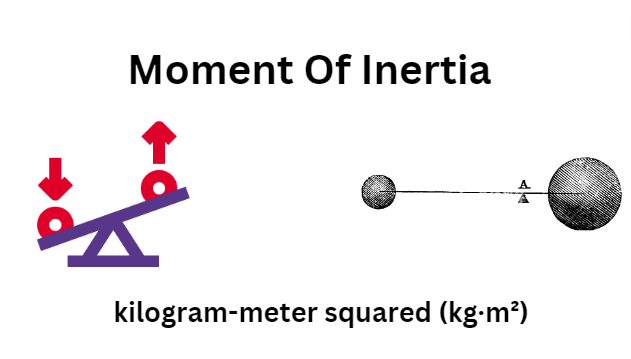Moment of inertia is a fundamental concept in physics that describes an object’s resistance to changes in its rotational motion. It calculates how the mass of an object is distributed along the axis of rotation and affects its rotational behavior. Moment of inertia plays an important role in understanding and predicting the rotational motion of various objects and systems. SI unit of moment of inertia is discussed below.
Detailed Explain About SI unit Moment Of Inertia
Moment of inertia, also known as rotational inertia, is a physical property of an object that describes its resistance to changes in its rotational motion. It calculates how the mass of an object is distributed along its axis of rotation.
When an object rotates about a fixed axis, different parts of the object have different distances from the axis. The moment of inertia takes into account both the mass of each element of matter and its distance from the axis of rotation. It gives how much force is required to change the rotational motion of the object.
Mathematically, the moment of inertia is calculated by summing the contributions of all the individual mass components of the object. The moment of inertia depends on the mass distribution and the shape or geometry of the object.
Objects with mass concentrated closer to the axis of rotation have less inertia, while objects with mass distributed farther from the axis have greater inertia.
Note: In summary, the moment of inertia is a property that describes an object’s resistance to changes in its rotational motion. It depends on the mass distribution and geometry of the object and is crucial for analyzing and predicting rotational dynamics in various applications.
The SI unit of moment of inertia is kilogram-meter squared (kg·m²). The moment of inertia represents the distribution of mass in relation to an axis of rotation and is derived from the basic SI units of mass (kilogram, kg) and distance (meter, m). The resulting unit, kg·m², quantifies the resistance of an object to changes in its rotational motion based on its mass distribution.

What Is the Formula Of Moment Of Inertia
The formula for calculating the moment of inertia depends on the shape and distribution of the mass of the object. Here are the formulas for a moment of inertia for some common shapes:
- Point Mass:
For a single-point mass, the moment of inertia about an axis of rotation passing through the point is zero. The formula is:
I = 0
- Thin Rod Rotating About Its Center:
For a thin rod of length L rotating about an axis perpendicular to the rod and passing through its centre, the moment of inertia is:
I = (1/12) * m * L²
Where m is the mass of the rod.
- Thin Rod Rotating About One End:
For a thin rod of length L rotating about an axis perpendicular to the rod and passing through one end, the moment of inertia is:
I = (1/3) * m * L²
Where m is the mass of the rod.
- Solid Cylinder:
For a solid cylinder with mass M, radius R, and axis of rotation along its central axis, the moment of inertia is:
I = (1/2) * M * R²
- Hollow Cylinder:
For a hollow cylinder with mass M, inner radius R1, outer radius R2, and axis of rotation along its central axis, the moment of inertia is:
I = (1/2) * M * (R2² + R1²)
- Solid Sphere:
For a solid sphere with mass M and radius R, rotating about an axis through its centre, the moment of inertia is:
I = (2/5) * M * R²
- Hollow Sphere:
For a hollow sphere with mass M, inner radius R1, outer radius R2, and axis of rotation through its centre, the moment of inertia is:
I = (2/3) * M * (R2² + R1²)
These are just a few examples, and the formulas for a moment of inertia can vary depending on the specific shape and mass distribution of the object. It is important to use the appropriate formula for the specific object or system being analyzed.
